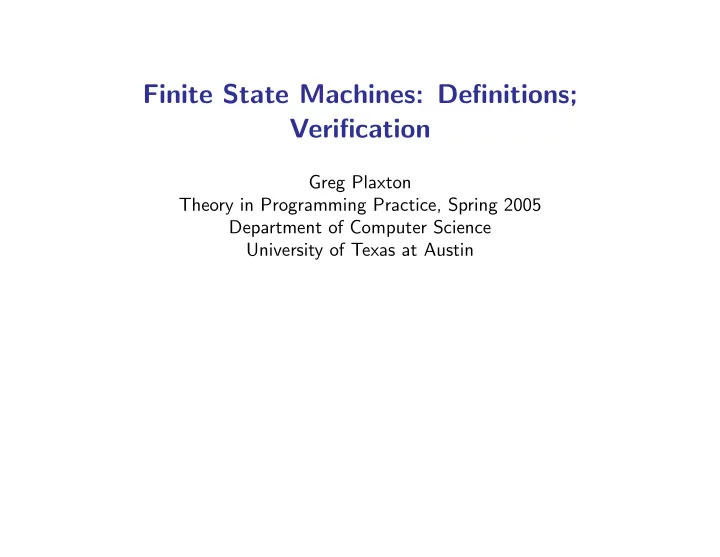

Finite State Machines: Definitions; Verification Greg Plaxton Theory in Programming Practice, Spring 2005 Department of Computer Science University of Texas at Austin
Finite State Machine: Definition • A (deterministic) finite state machine consists of: – A finite number of states, where one state is designated as the initial state, and a subset of the states are designated as accepting – A state transition function that specifies the next state for each state and input symbol • A finite state machine accepts or rejects each finite string over the input alphabet • To determine whether a given finite string is accepted, start in the initial state and repeatedly update the state according to the next input symbol and the state transition function – The input string is accepted if and only if this process terminates in an accepting state Theory in Programming Practice, Plaxton, Spring 2005
Finite State Machine: Correspondence to a “Language” • Let A denote the input alphabet of some FSM M • As we have seen, M accepts some subset of the set of all finite strings over A • The set of strings accepted by M is the language accepted by M Theory in Programming Practice, Plaxton, Spring 2005
Finite State Machine: Pictorial Representation • Each state is depicted by a circle • An arrow labeled “start” points to the initial state • Each accepting state has a double circle • The transition function is specified by drawing arrows labeled by either a single input symbol or a set of input symbols – The label on an arrow associated with a transition from state u to state v indicates which input symbols cause this transition to be taken – Normally, a transition is explicitly specified for each state and input symbol – Remark: If certain transitions are not explicitly specified, the intended interpretation is that any input string leading to an unspecified transition is rejected Theory in Programming Practice, Plaxton, Spring 2005
Verification of FSMs • In a previous lecture we designed a few simple FSMs that seemed to be correct in terms of accepting a specified language – Example: The finite state machine we designed to accept words containing the five vowels in order • How can we formally verify the correctness of such FSMs? – Our strategy is to label each state with (our guess as to) the set of finite strings leading to that state – These labels may be verified using induction (assuming that our guesses are correct) Theory in Programming Practice, Plaxton, Spring 2005
Verification Procedure • First, annotate each state with a predicate over finite strings – The predicate defines a set of input strings, namely, those for which the predicate holds (i.e., evaluates to true) – This corresponds to our guess as to the set of input strings leading to this state – As such, the sets of input strings defined by the annotations is required to partition the set of all input strings • Second, show that the predicate associated with the initial state holds for the empty string • Third, prove that for any transition from a state u to a state v on input symbol a , if some finite string x satisfies the state u annotation, then the finite string xa satisfies the state v annotation Theory in Programming Practice, Plaxton, Spring 2005
Verification Procedure: Why Does it Work? • Let x be an arbitrary input string • Let the given FSM M be in state u after processing x – Because M is deterministic, the state u is uniquely defined • Let v denote the unique state for which the associated annotation holds for x – The existence/uniqueness of v follows from the requirement that the state annotations partition the set of all input strings • We prove that u = v by induction on the length of x – The second part of the verification procedure handles the base case – The third part handles the induction step Theory in Programming Practice, Plaxton, Spring 2005
Verification Example: Parity • Design an FSM to accept all finite binary strings with an odd number of 0s and an odd number of 1s • Verify the correctness of your FSM Theory in Programming Practice, Plaxton, Spring 2005
Verification Example: Ascending Digits • Design an FSM to accept any finite string of decimal digits in which each successive digit is strictly higher than the preceding one (e.g., 038 or 13579) • Verify the correctness of your FSM Theory in Programming Practice, Plaxton, Spring 2005
Another Example • Design an FSM to accept all finite binary strings with an equal number of zeros and ones • Is this possible? Theory in Programming Practice, Plaxton, Spring 2005
Some Closure Properties of FSMs • Let FSMs M 1 and M 2 accept the languages L 1 and L 2 , respectively • Is it possible to give a general procedure to construct an FSM accepting L 1 ∪ L 2 from FSMs M 1 and M 2 ? • What about L 1 ∩ L 2 ? • What about L 1 ? Theory in Programming Practice, Plaxton, Spring 2005
Recommend
More recommend